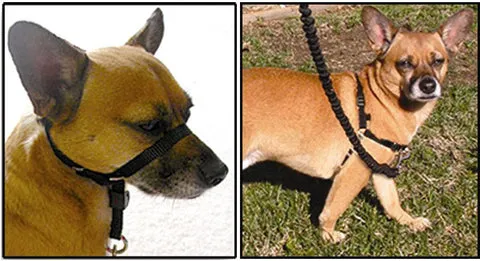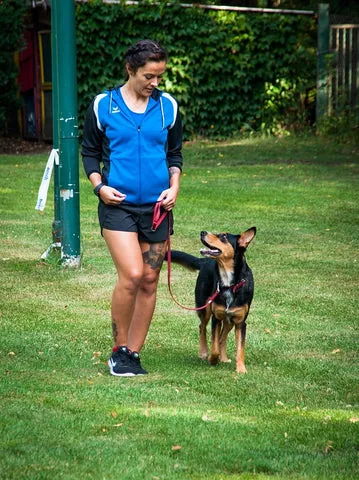Walking your puppy should be a joyous experience, a time for bonding and exploration. However, for many dog owners, it quickly turns into a battle of wills, with their enthusiastic furry friend tugging relentlessly on the leash. If you’ve ever wondered How To Walk A Puppy That Pulls, envision a future where your canine companion walks calmly by your side, stopping when you stop, turning when you turn, and confidently passing other dogs and people. This dream is achievable through consistent and positive leash training. Puppy leash training, while challenging, is incredibly rewarding and essential for enjoyable walks. This guide will help you transform your pulling puppy into a pleasant walking partner.
Preparing for Leash Training Success
Before you even step out the door, consider the right equipment to set both you and your puppy up for success. While traditional collars can put pressure on your puppy’s neck when they pull, certain tools can help manage the behavior while you teach them proper leash manners. A front-attachment harness is an excellent choice for most dogs. It discourages pulling by redirecting your puppy’s forward momentum when they tug, turning them gently to the side instead. For puppies with particularly strong pulling tendencies or for owners seeking maximum control, a head collar can be highly effective. It’s crucial that these tools are used with a leash no longer than 6 feet to prevent your puppy from gaining too much speed and potentially injuring themselves if they hit the end of the leash abruptly.
 A small tan dog wears a head collar on the left and a front-attachment harness on the right
A small tan dog wears a head collar on the left and a front-attachment harness on the right
When embarking on the journey of teaching your puppy not to pull, a simple yet powerful technique is the “stop and reward” method. This involves halting all forward movement the moment your puppy pulls on the leash. As soon as the leash slackens, you resume walking and reward your puppy with praise and a high-value treat when they are walking calmly by your side. A treat bag worn around your waist can make this process much easier. If your puppy isn’t highly motivated by food, a favorite tug toy, chew toy, or a quick game of fetch with a ball can serve as a suitable reward. Consistency with this method teaches your puppy that pulling leads to a standstill, while walking politely keeps the adventure going and earns them good things. This foundational step is key to establishing good leash habits from the start.
Step-by-Step Puppy Leash Training
Mastering loose-leash walking requires patience and a structured approach. Here’s a detailed breakdown of how to train your puppy to walk politely on a leash.
Step 1: Make Walking with You a Delightful Experience
Begin your puppy’s leash training in a familiar, low-distraction environment, like your backyard. Equip your puppy with a standard harness and a long rope or leash (10-20 feet – avoid retractable leashes at this stage). Prepare some irresistible, pea-sized treats, such as fresh meat or cheese. Decide which side you prefer your puppy to walk on (left is traditional). This will be the side where you consistently deliver treats.
Walk briskly and randomly around your yard. The instant your puppy chooses to walk beside you, offer enthusiastic praise and a treat right by your thigh on your chosen side. If they continue to stay with you, reward them for every few steps you take together. As they improve, you can gradually reduce the frequency of rewards. If your puppy seems uninterested, try again when they are a bit hungrier. Practice until your puppy spends more time walking alongside you than not. Knowing the best way to leash train your puppy starts with making proximity rewarding.
Step 2: Pay Attention to Where Your Human Is Going
This step focuses on teaching your puppy to re-engage with you when they become distracted or lag. While walking in your yard, wait for a moment when your puppy is off sniffing or lagging behind. Say “let’s go” in an upbeat tone, perhaps slapping your thigh a few times to get their attention, and then turn and walk in the opposite direction.
When your puppy catches up, reward them with praise and a treat next to your preferred side. If they quickly rejoin you, give an extra reward. If the leash tightens and they don’t respond, stop walking and apply gentle, consistent leash pressure. The pressure serves as a gentle reminder, not a forceful tug. As soon as your puppy moves towards you, release the pressure and praise them. Once they catch up, reward them generously. Continue practicing this until your puppy consistently returns to your side when you say “let’s go,” even after veering off.
Step 3: Scheduled Sniffing and Potty Breaks
Puppies need time to explore and relieve themselves during walks, but it’s important that you dictate when these breaks occur to reinforce good manners. While practicing, approximately every five minutes, instead of a food reward, say “go sniff” and allow your puppy some free time to explore or go potty on the leash. This is a privilege; if they pull during this free time, immediately say “let’s go” and change direction, ending the break. When you’re ready to resume formal walking, say “let’s go” and start walking forward. This teaches your puppy that authorized sniff breaks are a reward for good behavior.
Step 4: Mastering Control with a Shorter Leash
As your puppy progresses, continue practicing steps one through three in your yard, gradually transitioning to a shorter leash, eventually reaching the standard 6-foot length. Introduce variations in your walking pace—extra fast or slow—and practice stopping and changing directions frequently. Reward your puppy if they can maintain their position by your side during these challenges.
At this stage, you can begin to reduce the frequency of rewards for simply walking by your side in normal circumstances. However, continue to reward them generously when they successfully navigate challenging situations, such as maintaining a loose leash during a sudden stop, a quick turn, or when encountering distractions like other animals or people. This helps to solidify their understanding that maintaining focus on you and a loose leash is always rewarded, especially when it’s most difficult. For more advanced training, consider how to get your dog not to pull while walking on trails with varied terrain.
Taking Leash Training to the Street
Once your puppy is proficient in the yard, it’s time to introduce them to the real world. Your neighborhood walks will present new distractions—friendly strangers, squirrels, other dogs—so be prepared. Continue to use the same techniques: say “let’s go” and begin walking. If your puppy forgets their manners or starts to pull, calmly say “let’s go” and turn immediately, walking in the opposite direction.
Reward them with treats when they walk politely beside you. Remember to offer extra high-value treats when it’s particularly challenging for them to stay focused on you amidst distractions. And don’t forget to grant those authorized sniff breaks. Maintaining consistency and patience as you transition to busier environments is key to reinforcing the positive behaviors you’ve established.
 Woman walking attentive black and tan dog
Woman walking attentive black and tan dog
Challenging Your Puppy During Leash Training
To further solidify your puppy’s loose-leash skills, introduce controlled challenges. Outfit your puppy in a standard harness with a 6-foot leash. Toss a ball or a treat about 20 feet away from you and your puppy. If they pull towards the object, immediately say “let’s go” and turn, walking in the opposite direction. If they walk calmly beside you as you approach the object, allow them to reach it and claim it as their reward. To make this easier initially, you might use a longer leash or a less desirable object. This exercise teaches self-control and reinforces that walking politely leads to highly desirable rewards.
Troubleshooting Common Pulling Issues
Even with consistent training, you might encounter some common challenges:
- Puppy crossing in front of you: If your puppy repeatedly crosses your path, stomp or shuffle your feet slightly to make your presence more obvious and encourage them to stay to your side.
- Puppy lagging significantly: If your puppy lags, they might be frightened or not feeling well. Use plenty of encouragement rather than pulling them along. If they are lagging to sniff or potty, simply keep walking, applying only gentle leash pressure, and reward them generously when they catch up.
- Alternating between walking beside you and pulling: If your puppy seems to alternate between good behavior and pulling after you’ve practiced these steps, shift your focus. Instead of rewarding them for simply returning to your side after a pull, concentrate on rewarding them for taking a larger number of consecutive steps by your side. This helps build endurance in their polite walking.
How to Train a Puppy to Walk On a Leash and Heel
Heel training teaches your puppy to walk very closely and attentively beside you, which is particularly useful for short periods in highly distracting environments. Begin practicing heel indoors. Hold a treat in your closed fist, let your puppy sniff it, then say “heel” or “let’s go” and take a couple of steps, leading them along with the treat near your thigh. Praise and reward them with the treat when they follow your fist with their nose.
Next, practice having your puppy follow your empty fist. Continue to praise and reward them for every couple of steps they follow. Gradually increase your standards with each session. Your closed fist will become the hand signal for “heel.” Once proficient indoors, introduce this command outside in increasingly distracting situations. This command provides an extra layer of control when you need your puppy to be hyper-focused on you. Understanding how to train a puppy not to pull is enhanced by mastering specialized commands like heel.
Effective leash training transforms walks from a struggle into a pleasurable activity for both you and your puppy. By consistently applying these methods, focusing on positive reinforcement, and maintaining patience, you’ll soon enjoy peaceful strolls with a well-behaved companion. Explore our comprehensive resources for more puppy training tips and essential supplies to support your journey.
